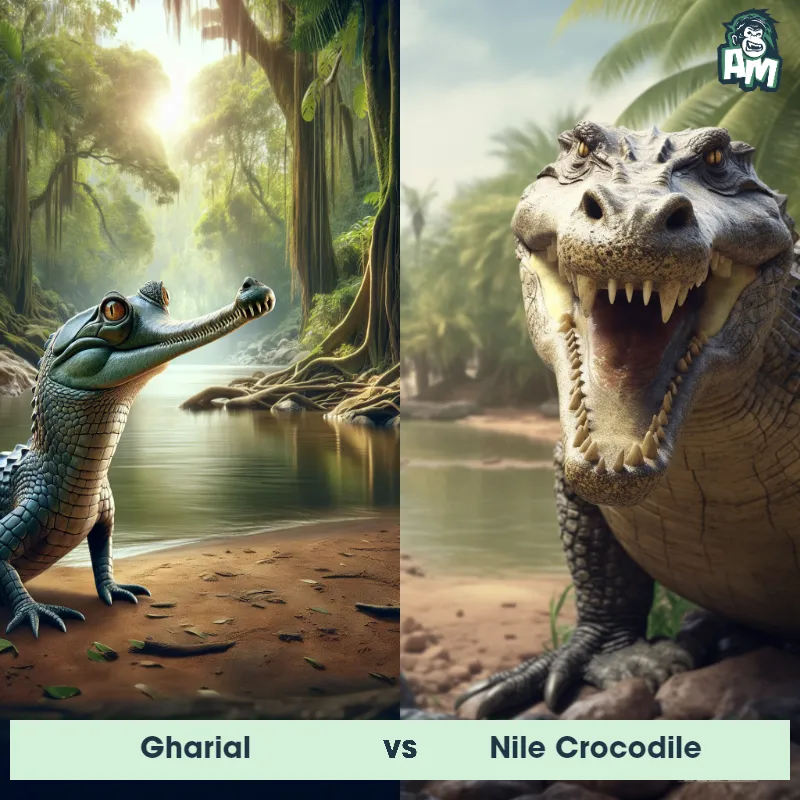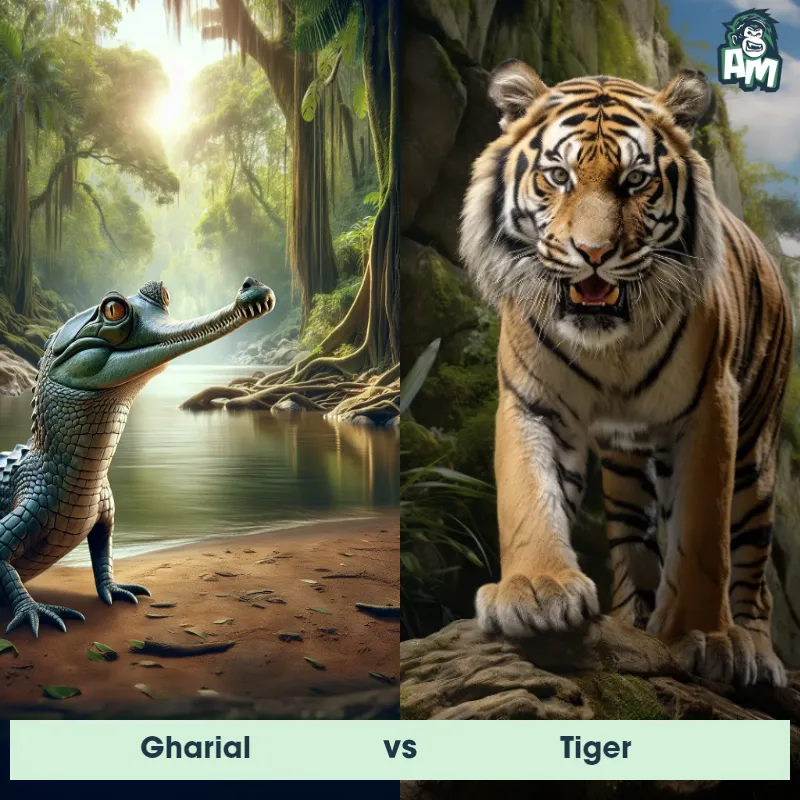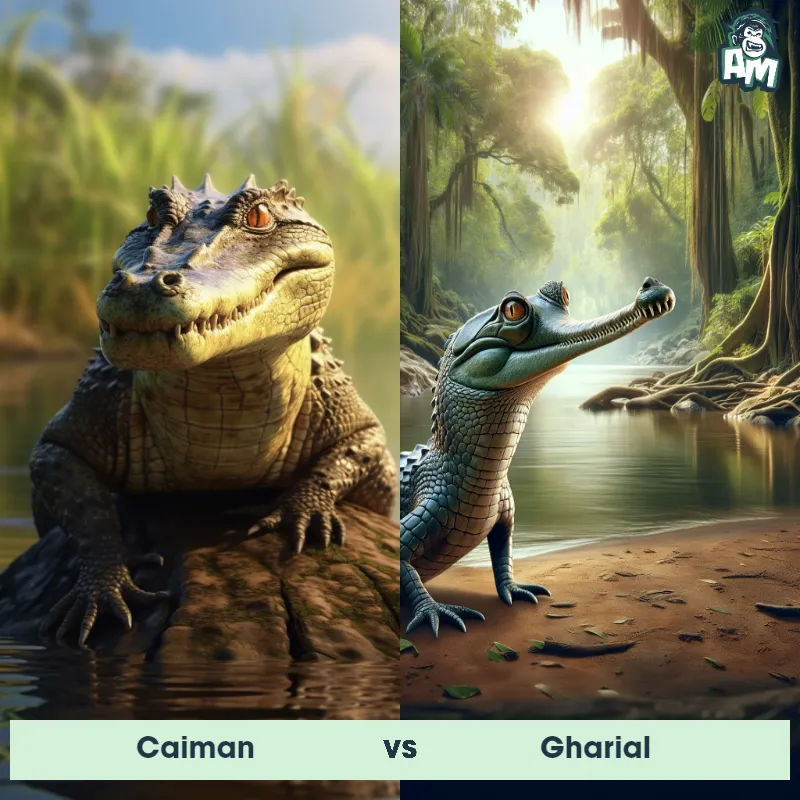The Gharial
The Gharial, also known as the Indian gharial or fish-eating crocodile, is a unique species of crocodile found in the freshwater rivers of the Indian subcontinent. It is known for its long, slender snout which houses numerous interlocking teeth, making it a highly efficient fish catcher. The body of the Gharial is covered in tough, armored scales, varying in color from olive green to dark grey. With a length reaching up to 20 feet, it is one of the largest crocodile species in the world. Gharials are well-adapted for life in the water, with powerful webbed feet and a muscular tail that propels them swiftly through the rivers.

| Gharial | |
|---|---|
| Size | Up to 20 feet (6.1 meters) |
| Weight | Up to 2,000 pounds (907 kilograms) |
| Speed | Speed: 6 mph (9.6 km/hr) |
| Key Strength | Powerful jaws and long snout for catching fish |
| Biggest Weakness | Teeth not designed for tearing flesh |
| Scientific Name | Gavialis gangeticus |
| Family | Gavialidae |
| Habitat | Rivers |
| Geography | India and Nepal |
| Diet | Fish |
| Lifespan | 30 years - 60 years |

The Gharial
The Gharial, also known as the Indian gharial or fish-eating crocodile, is a unique species of crocodile found in the freshwater rivers of the Indian subcontinent. It is known for its long, slender snout which houses numerous interlocking teeth, making it a highly efficient fish catcher. The body of the Gharial is covered in tough, armored scales, varying in color from olive green to dark grey. With a length reaching up to 20 feet, it is one of the largest crocodile species in the world. Gharials are well-adapted for life in the water, with powerful webbed feet and a muscular tail that propels them swiftly through the rivers.
Fun Fact: The Gharial is often referred to as the "Ganges gavial" due to its presence in the Ganges River in India, where it primarily resides.
| Gharial | |
|---|---|
| Size | Up to 20 feet (6.1 meters) |
| Weight | Up to 2,000 pounds (907 kilograms) |
| Speed | Speed: 6 mph (9.6 km/hr) |
| Key Strength | Powerful jaws and long snout for catching fish |
| Biggest Weakness | Teeth not designed for tearing flesh |
| Scientific Name | Gavialis gangeticus |
| Family | Gavialidae |
| Habitat | Rivers |
| Geography | India and Nepal |
| Diet | Fish |
| Lifespan | 30 years - 60 years |
Gharial Matchups
We use AI to simulate matchups between the Gharial and other animals. Our simulation considers size, strength, and natural predatory behaviors to determine the most likely outcome.
Gharial: Diet, Predators, Aggression, and Defensive Behaviors
What do Gharials eat?
Gharials primarily feed on fish, making them piscivorous predators. They use their long, slender jaws filled with sharp teeth to catch fish in the water. However, adult Gharials may also consume small vertebrates such as frogs or insects, but fish make up the majority of their diet.
Do Gharials have any predators?
As apex predators in their habitat, adult Gharials do not have many natural predators. However, their eggs and hatchlings are vulnerable to predation by large birds, mammals, and other reptiles. Crocodiles and monitor lizards are known to prey on Gharial eggs and juveniles.
Are Gharials aggressive?
Gharials are not typically aggressive towards humans unless provoked or threatened. They are generally shy and elusive animals that prefer to avoid confrontation. However, during the breeding season, male Gharials can become more territorial and aggressive towards other males competing for mates.
Do Gharials fight?
Male Gharials may engage in physical fights during the breeding season when competing for mates and territory. These fights involve displaying their dominance through physical posturing, vocalizations, and sometimes clashing their long jaws together in a display of strength. However, these fights rarely result in serious injuries.
How do Gharials defend themselves?
Gharials have several defense mechanisms to protect themselves from potential threats. Their primary defense is their aquatic lifestyle, allowing them to quickly retreat into the water to escape predators. Additionally, Gharials can use their powerful tails and jaws to defend themselves if necessary. They may also rely on their camouflaged coloration to avoid detection by predators.
What is the biggest weakness of a Gharial in a fight?
Despite their powerful jaws and tails, Gharials have a relatively slender and fragile body compared to other crocodilians. This makes them vulnerable to injury in physical fights with larger and stronger predators. Additionally, their specialized diet of fish may limit their ability to sustain prolonged physical confrontations with other predators.
Fun Fact: Unlike other crocodile species, the Gharial has an incredibly thin jawline, with males sporting a distinctive bulbous growth at the tip of their snout known as a "ghara," which is used for vocal resonance during mating displays and territorial battles.
Fun Fact: The Gharial's diet primarily consists of fish, and to catch its prey more efficiently, it possesses specialized sensory organs on its snout known as “interdigitated mandibular canals,” which allow it to detect subtle water movements made by fish, enhancing its hunting accuracy.
















